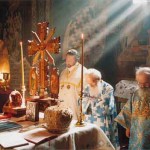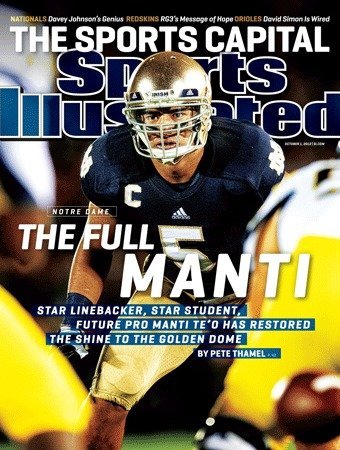By Michael and Paul Barker
Who is a Manti Te’o?
Manti Te’o’s story is very unique and very strange. Manti is a college football player that plays linebacker for Notre Dame. He is one of the top linebackers in the nation and is selected to be the 7th picked in the NFL draft this year. He was runner up to the Heisman trophy, the most coveted award in college. He is also one of the most decorated athletes in 2012 winning the Lott Trophy, Maxwell Award, Chuck Bednarik Award, Walter Camp Award, Bronko Nagurski Trophy, Butkus Award, Lombardi Award, ARA Sportsmanship Award and much more. In addition, he played for the BSC national title this year. Manti Te’o is also a Mormon. He based his decision on going to Notre Dame on a prayer.
 This is where it gets weird:
This is where it gets weird:
In September we found out through Manti that his grandmother passed away and just hours afterwards, his girlfriend also passed away. Lennay Kekua, the girlfriend, was diagnosed with leukemia after being in a serious car accident in California. Upon hearing the news Manti led Notre Dame in an inspirational upset against Michigan State. Manti had 12 tackles. Manti received a ton of support from the school, media, and friends. The story of the two deaths was also played out before the national title game. Everyone likes an inspirational story so the press and the fans ate it up. On January 16th, Deadspin.com released an article stating the whole ordeal with the girlfriend Lannay Kekua was a hoax. There was no person named Lannay Kekua. The story became stranger and stranger as more facts came out. I won’t go into the details of the story, but you can click here for a full timeline of the whole Manti Te’o / Lennay Kekua story.
Lying For the Lord
“Lying for the Lord” was a phrase that was coined around the time that polygamy was under the watchful eye of the US Government. Communities were told not to talk to visitors because there was a chance they were sent from the government to investigate polygamy. If someone was questioned about polygamy they denied it, hence the term “lying for the Lord” came about. As one can imagine this caused problems in Mormon communities. Suppose a husband got word that a Federal Official was coming to his town. He would leave and go over to the next town. What if the next town didn’t recognize him? What would the assumption be? That he was a clandestine Federal Official. See the problem?
Of the practice of “lying for the Lord”, B. Carmon Hardy wrote:
“When the national campaign against Mormon polygamy became intense, the use of non-truths spread rapidly to the larger body of the church. In his account of the legislative and constitutional extremes to which Idaho legislators felt they must go, John D. Hicks described those Mormon tactics that provoked the response. It was alleged, he said, that “when polygamists were prohibited from voting, the Mormons promptly swore that they were not polygamists; when those who taught polygamy were discriminated against, everybody immediately became silent on the subject; and when members of organizations which advocated polygamy were denied the ballot, they withdrew…from the Mormon Church.”1 Children were instructed to deny knowledge of family relationships, of their parents’ whereabouts, and even of their own last names.2 One church authority was so concerned about the pervasiveness of intentional falsehood that he feared for its effect on the moral fiber of Mormon society. In a letter to President John Taylor in 1887, Charles W. Penrose expressed concern that “the endless subterfuges and prevarications which our present condition impose…threaten to make our rising generation a race of deceivers.”3 (Lying for the Lord: An Essay, Solemn Covenant: The Mormon Polygamous Passage. Appendix I. B. Carmon Hardy. University of Illinois Press Urbana and Chicago, 1992, pg. 363)
Part of the justification for “lying for the Lord” was that many Mormons of the nineteenth and early twentieth centuries believed polygamy was a salvific, divine practice revealed through the Lord’s prophet; the same way many LDS members see temple sealings as being salvific. Lying about it seemed like the higher road since polygamy was from the Lord and what does a government know about revealed word from the Lord? People today might find this morally repugnant, but just think about it. If the government told a 21st century Christian not to baptize (a ritual that is seen by millions of Christians as being salvific), they would most likely do it in secret and would be duplicitous when asked about the ritual.
Elder Dalin H. Oaks said the following:
“Some have suggested that it is morally permissible to lie to promote a good cause. For example, some Mormons have taught or implied that lying is okay if you are lying for the Lord… As far as concerns our own church and culture, the most common allegations of lying for the Lord swirl around the initiation, practice, and discontinuance of polygamy. The whole experience with polygamy was a fertile field for deception. It is not difficult for historians to quote LDS leaders and members in statements justifying, denying, or deploring deception in furtherance of this religious practice….there will be times when moral imperatives clash. Sometimes, people who wish to make moral choices are faced with difficult choices. For example:
- if a rapist breaks into your house, and demands to know where your teenage daughter is hiding, are you morally obligated to tell him?
- if you are a French Christian hiding Jews from the Nazis in 1941, are you obliged to tell the SS about the whereabouts of the Jews if they ask? Is it wrong to lie to them?
- if the government seeks to destroy families formed under plural marriage, is breaking up those families appropriate? Should one abandon wives and children without support, or avoid telling the whole truth?
“…My heart breaks when I read of circumstances in which wives and children were presented with the terrible choice of lying about the whereabouts or existence of a husband or father on the one hand or telling the truth and seeing him go to jail on the other. These were not academic dilemmas. A father in jail took food off the table and fuel from the hearth. Those hard choices involved collisions between such fundamental emotions and needs as a commitment to the truth versus the need for loving companionship and relief from cold and hunger.
“My heart also goes out to the Church leaders who were squeezed between their devotion to the truth and their devotion to their wives and children and to one another. To tell the truth could mean to betray a confidence or a cause or to send a brother to prison. There is no academic exercise in that choice!
“…I do not know what to think of all of this, except I am glad I was not faced with the pressures those good people faced. My heart goes out to them for their bravery and their sacrifices, of which I am a direct beneficiary. I will not judge them. That judgment belongs to the Lord, who knows all of the circumstances and the hearts of the actors, a level of comprehension and wisdom not approached by even the most knowledgeable historians.
“…I ask myself, “If some of these Mormon leaders or members lied, therefore, what?” I reject a “therefore” which asserts or implies that this example shows that lying is morally permissible or that lying is a tradition or even a tolerated condition in the Mormon community or among the leaders of our church. That is not so” (Dallin H. Oaks, “Gospel Teachings About Lying,” BYU Fireside Address, 12 September 1993, typescript, no page numbers; also printed in Clark Memorandum [of the J. Reuben Clark School of Law, Brigham Young University] (Spring 1994)).
Orthopraxy and Orthodoxy and the Need for Identity
Within Mormonism, as well as other faith traditions, there are ways to show your orthodoxy (correct belief) through one’s orthopraxy (correct action). One of  the strongest ways orthopraxy is manifested is through correct practice of sexual mores. For 19th century and early 20th century Mormonism, that manifested itself through the practice of polygamy. A very important way of showing that you were a true believer (orthodoxy), was by entering into polygamy (orthopraxy). When the LDS church gave up the practice of polygamy an important orthopraxic form of identity and other things necessarily filled the void, such as Mormonism’s full embrace of its unique code of health called the Word of Wisdom. Specifically regarding sexual mores, the sexual practice that has now taken the place of polygamy, is the law of chastity. Meaning sexual relations are only to take place between ONE husband and ONE wife. But, how are we to really know if someone isn’t having pre-marital sex? There are interesting cultural markers that come into play and these cultural markers are often held in tension with Mormonism’s attempt to assimilate into the greater culture and appear “normal”.
the strongest ways orthopraxy is manifested is through correct practice of sexual mores. For 19th century and early 20th century Mormonism, that manifested itself through the practice of polygamy. A very important way of showing that you were a true believer (orthodoxy), was by entering into polygamy (orthopraxy). When the LDS church gave up the practice of polygamy an important orthopraxic form of identity and other things necessarily filled the void, such as Mormonism’s full embrace of its unique code of health called the Word of Wisdom. Specifically regarding sexual mores, the sexual practice that has now taken the place of polygamy, is the law of chastity. Meaning sexual relations are only to take place between ONE husband and ONE wife. But, how are we to really know if someone isn’t having pre-marital sex? There are interesting cultural markers that come into play and these cultural markers are often held in tension with Mormonism’s attempt to assimilate into the greater culture and appear “normal”.
There is a big force in Mormon culture for all young men to serve a two year mission. As of late it seems the culture has given exceptions to this rule for athletes. Steve Young, Danny Ainge, Jimmer Ferdette and Manti Te’o did not serve missions. The Mormon culture will label their work and spotlight on the field/court as missionary work because they will bring positive attention to the church. And for Mormons this is the perfect marriage.
Athletes that play well, “normalize” Mormons while still fulfilling the cultural marker of being a missionary; it removes the tension that is often there between maintaining Mormonism’s peculiarity without looking too weird. With Manti Te’o, he was given even a bigger responsibility by our culture since he is a Mormon playing at a Catholic school. Thus we see non-full-time missionary work being elevated almost to the same level as the Full-time Missionary. Manti and others like him are thus showing their orthodoxy through a non-traditional orthopraxic manner. They are achieving our cultural marker.

Sports Illustrated Cover featuring Manti Te’o not in a bikini
Now what about chastity? I think it is no secret that athletes are known, for better or for worse, for their sexual prowess. One way that Mormons know whether or not a boy has been chaste (orthopraxy) is if the young man serves a mission; you have to be chaste, or have repented if you were a bit of a floozy in order to serve a LDS mission. So, by this huge cultural marker, we assume we know one’s level of orthodoxy. But what of the Jimmer Ferdette’s and Manti Te’o’s of Mormonism? How do they show Mormonism their chastity? If you go to BYU, you have a bishop’s endorsement, and so it goes without saying, you are chaste. Right? But what about Te’o? He’s going to a Catholic school. However, his girlfriend “lived” out of state. So all of us Mormons could let out a congregational sigh of relief. There’s no way those two were fooling around. But with all of the recent news about his girlfriend and her death being a hoax, everything is turned up on its head. And for Mormons, who are often seen as being provincial, this is a bit of an embarrassment. Is there a way to re-interpret this new, embarrassing data?
Could it be that as a Mormon, attending a Catholic school, with no indication he would ever serve a full-time mission, that like the 19th and early 20th century Mormons, Manti Te’o was “lying for the Lord”? Think about it. Have you ever known a young LDS man who has worn a t-shirt and long boxer-briefs or compression shorts so as to look like a returned missionary and hopefully garner the attention of a BYU co-ed? That young man is lying. But he is doing it in a way that identifies himself as orthodox. He is attempting to show that he is fulfilling a certain cultural expectation with hope of a reward. Without going too far off on a tangent about how this mentality objectifies women as something to “get”, or “win”, we can all agree this is just weird and nefarious.
With Manti Te’o, instead of lying to garner the affection of a LDS young woman, or to protect the sexual practices of early-Mormonism, could he have been lying to show that he was practicing the sexual mores of a good twenty-first century Mormon man (orthopraxy)? He had no other way of doing it. All the other normal markers to show his orthodoxy via the orthopraxic act of abstinence from non-marital sex are not there: Catholic school (not BYU) and no mission served. If this were to be true, it should bring into question our own cultural expectations and whether or not they are healthy. To quote Jared Anderson, “I want a Mormonism that maximizes benefit, minimizes harm, while maintaining its uniqueness.”
___________________________
Notes and further readings:
1.John D. Hicks, “The Constitutions of the Northwest States,” University Studies Published by the University of Nebraska 23 (Jan.-April 1923): 138-39.
2. See above, 50, 371.
3. Charles W. Penrose to President John Taylor, 16 Feb. 1887, John Taylor Letter File, typewritten transcriptions by Raymond Taylor, University of Utah Library, Salt Lake City.
Click here to read: Lying for the Lord: An Essay, Solemn Covenant: The Mormon Polygamous Passage. Appendix I. B. Carmon Hardy. University of Illinois Press Urbana and Chicago, 1992, pg. 363
Dr. D. Michael Quinn, The Mormon Hierarchy: Origins of Power, pg. 112, 327 – note 36
Click here to read: Dr. D. Michael Quinn, LDS Church Authority and. New Plural Marriages,. 1890-1904, in Dialogue: A Journal of Mormon Thought






It never occurred to me that the situation might have something to do with Te’o’s “Mormon-ness”. I tend to think it’s more likely that this is related to a more pervasive cultural phenomenon: the diminished capacity of Te’o’s generation to engage in meaningful person-to-person interaction and establish meaningful relationships that is due to increased “virtual” online interaction. Maybe he just had a hard time relating to people. I think tying it to his faith may be a stretch, but perhaps you’re right. However, it’s a genius way to increase traffic to your site–I’m sure Google is blowing up with “Manti Te’o” searches. I’m not saying that was your intent–but it can’t hurt. 🙂
Good points on all accounts Mike!
You guys know your my boys, but I think this is a big stretch and assumption. I don’t really understand everyone’s infatuation with this story. It does seem like something weird is up, but coming to the conclusion that he was “lying for The Lord” is a bit much.
James,
Your criticism may have some validity. However, Paul and I have been looking for a way, for quite some time, to critique Mormon-athletes and celebrities regarding how they often get a pass when it comes to our (seen) religious expectations and obligations. This whole Manti-gate presented the perfect opportunity to do so.
I have also been trying to figure out how to bring up the whole “lying for the Lord” thing for a long time and this just seemed too perfect of a confluence of events.
Your my boy too. Peace out hommie.
Procrustes was a strage host in Greek Mythology. He invited guests to come dine with him and then offered them a bed. They never fit the bed perfectly, so he tortured them until they did, either stretching them or, in later tellings, lopping off the parts that didn’t fit. Lying for the Lord is an interesting topic, but you have taken your topic and laid it in a Procrustean bed. Is there some evidence that he felt inspired by the Lord or LDS culture to lie? It seems that Te’o was delivered a new set of facts that didn’t fit reality so he tortured the facts to fit a preconceived narrative. Haven’t you done the same? Your narrative is, Mormons need to seriously examine the whole concept of lying for the Lord. Te’o’s facts don’t fit your preconceived narrative, and yet you fit him to your bed anyway.
Yeah, I’ll agree with the other commenters on here that it’s a stretch. I don’t see how lying for the Lord fits Te’o’s story. There are plenty of other things that fit that premise better. I think the infants on infantsonthrones.com and Dan Wotherspoon hit Te’o’s predicament rather well. Lying for the Lord? Don’t see it. We teach that Satan decieves with half truths and is therefore lying. Maybe an article can be written how the correlation department stabilizes the facts, cherry picks the things they find faith promoting as a form of lying for the Lord.
That was a great podcast and yes, it was a strrrrrrretch. Dan did a great job covering this!
Josh Mangelson, *sterilize